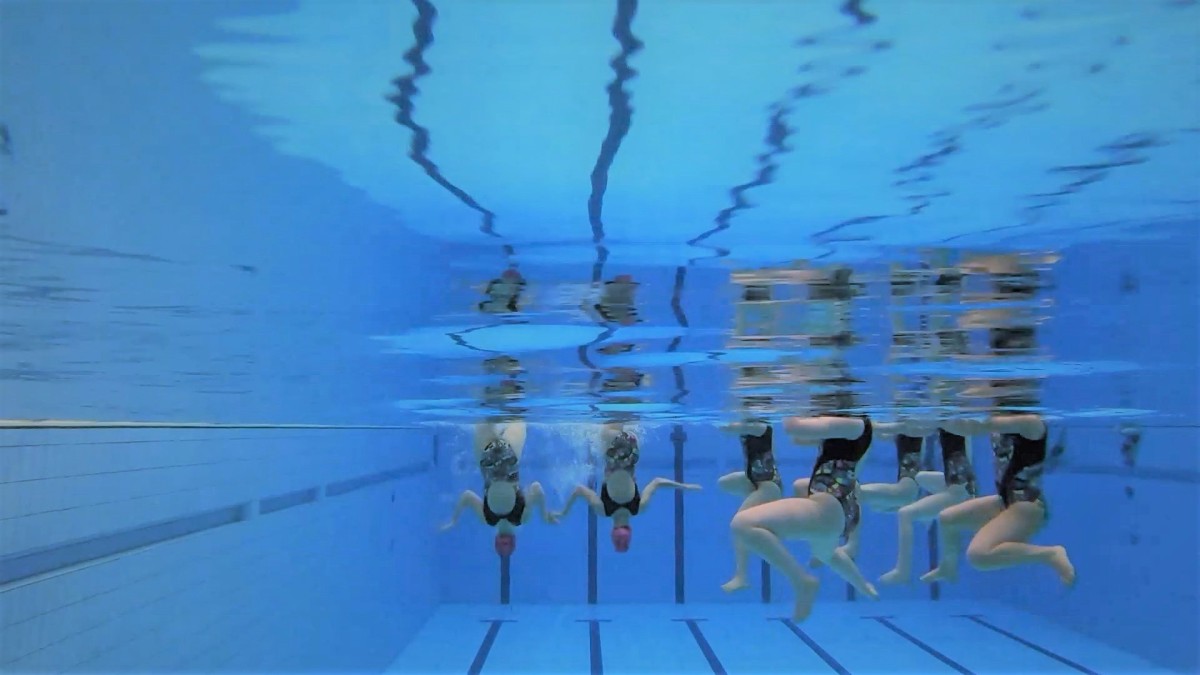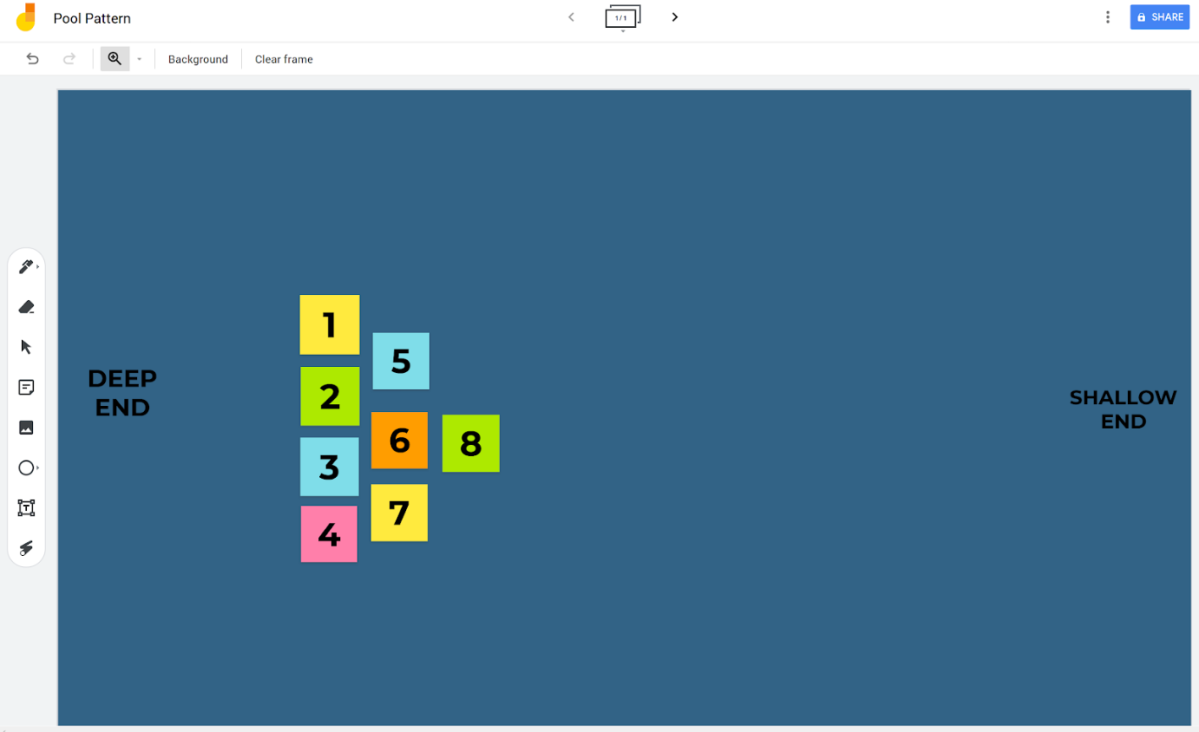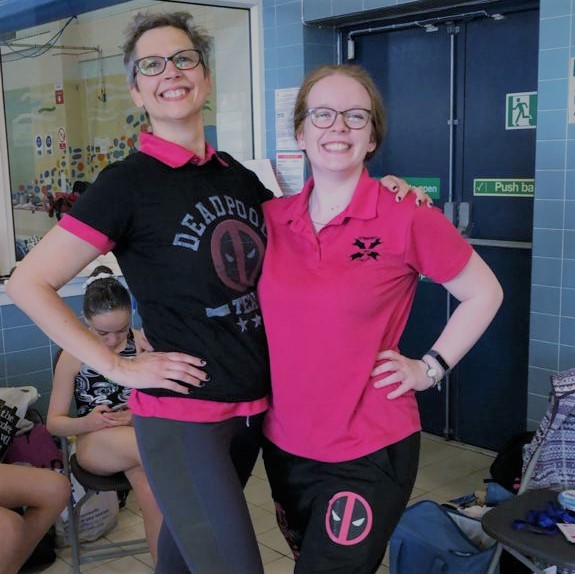Note, this post was originally published on sarahhale.dev!
I’ve had many people ask me how we can continue to train during Covid-19 – with many people expressing surprise that synchro can be done without a pool.
In normal times, we actually do a lot of training outside the pool. Synchro requires great strength, stamina, flexibility and agility. We use land and pool training to help develop this. In pandemic times, all access to pools have closed, so we have had to adapt our training regimes. It’s definitely trickier to train without any pool sessions, but it was important to us that we try our best to adapt so that when we get back to the pool, we won’t be starting at zero.
What is Synchro?
Before I talk about how we have adapted our training regimes, a quick intro to the sport is necessary.
Synchronised swimming is commonly known as ‘synchro’ in the community. In 2017, the sport was renamed as ‘Artistic Swimming’ by FINA (read more here), so when searching for info about the sport, you may need to use both terms.
The sport is a hybrid form of swimming, dance, and gymnastics, consisting of swimmers performing a synchronised routine (either solo, duet, trio, mixed duet, free team, free combination, and highlight) of elaborate moves in the water, accompanied by music. Artistic swimming is governed internationally by FINA, and has been part of the Summer Olympics programme since 1984.

What can’t be done without a pool?
There are things that we are unable to do without pool access, for example, practising sculling techniques, determining if a creative movement for a new solo / duet routine is possible in the pool (and if it looks as impressive as we imagine!) and of course, spatial awareness (knowing where your teammates are in relation to you, and the rest of the pool).

What can be done without a pool?
As mentioned above, we already did a lot of training outside of a pool. We have had to be a little more creative in our approaches to this given our land training was often in person and in groups.
So, what did we do? We used zoom, a lot.
Land training
For land exercise training, it wasn’t too much of a hurdle to transition from group training to video based training. We set up specific land training times, the coach then led the session via zoom, with all the swimmers following along. For younger swimmers, we found it was useful to have another coach watching the group to make sure they were following along with the exercises correctly and safely, as the coach leading the session was often actually doing the exercises themselves.
Walkthroughs
This is an important aspect of land training, at all times. A walkthrough is when you use your arms to represent what would be leg movements in the pool, when you’re practicing on land. See some examples below:
On the right: what the movement looks like in the pool.
You can do land walkthroughs to counts or to music. Doing a routine ‘to counts’ is when the coach or the swimmer counts the music out loud whilst doing the corresponding body movements.
This practice is quite straightforward to do in person – use one phone to play the music on loudspeaker, have the swimmers do the walkthrough, start and stop (and repeat!) sections as needed. It’s a great way to make sure all the swimmers are doing everything exactly the same, and understand the counts they are supposed to be doing things on, and the patterns they should be in.
Translating land walkthroughs to zoom was tricker than expected, due to the difference in internet speeds for all the swimmers on the call. It was definitely better than doing nothing! But as a coach, it did mean that I had to focus on other aspects of the walkthrough practice (posture, facial expressions, movement precision) rather than timing.

In order to ensure that the timing was correct (along with other aspects of correctness), we had the swimmers record their walkthroughs separately in their own time and post them to our WhatsApp group each week. We paired the swimmers up with each other and asked them to give peer based individual feedback. This really helped!
This example is focused on our team practices, but we also did it for solo and duet routines as well.
Pool patterns
One thing that video practises couldn’t solve was how to practice walkthrough patterns. This is really difficult to do when you’re not able to stand next to each other!
To solve this, we used Jamboard, whilst on a group video call. Each swimmer had a sticky note (in the real example, the sticky note had their name on it, but for this illustration, I’ve changed it to numbers), and they used their own device (phone, laptop) to move their sticky note to the correct pattern position. I found that it was easiest to not use music for this, but rather, say ‘next pattern’ and let them all change. Moving a sticky note on a jamboard was more difficult than doing a side step to the correct place in real life!
This exercise worked surprisingly well. We’ll probably continue to use these even after normal training can resume.

Morale & Motivation
One thing we were extremely conscious of was how morale was being affected due to this situation. My fellow coach (the amazing Vicky Peakman) came up with an excellent idea to end each weekly group walkthrough session with a bit of fun – often this was in the form of a kahoot quiz, or sometimes we would play drawful together. I am super impressed that she managed to come up with a NEW quiz every week, for 5 months!
She also had the excellent foresight to think about how we could keep the swimmers motivated and help keep them fit and healthy during these times at the start of lockdown, which meant I felt super prepared, and confident that we could support our swimmers during lockdown.
To help the swimmers keep motivated, and so that we the coaches could keep track of what they were doing (in case they were over training in one area for example) and their morale, we asked each swimmer to complete a lightweight form each day.
She then collated everything and provided some helpful and cool charts for each individual swimmer each week. This also helped us ensure that the activities, workouts that we were providing were useful.

We also participated in the first ever artistic swimming worldwide workout with some of the best athletes of our sport! This was super challenging but great fun. You can watch it here:
Finally, one of my duets participated in the ‘bathtub challenge’. I was super impressed at how they managed to choreograph and co-ordinate this remotely!

(Make sure you have the sound on!).
Finally, did any of this make a difference?
In my view, yes! The swimmers were recently allowed to return to the pool for some socially-distant training (which is a challenge in itself as one of my frequent bits of feedback is ‘swim closer together!’ but in these new times, they have to stay 2m apart even in the pool!) and the swimmers surprised themselves with how much they were still able to do. Their stamina and performance hasn’t dropped, and their routine execution has definitely improved!
Thanks
I couldn’t have supported the Edinburgh Synchro Junior Swimmers without the tremendous amount of support I got from my fellow coach, Vicky Peakman. She is incredible and nothing seems to faze her! In this post I have explained what we did during lockdown, but she was the driving force behind making this happen. For that, she has my eternal gratitude.

